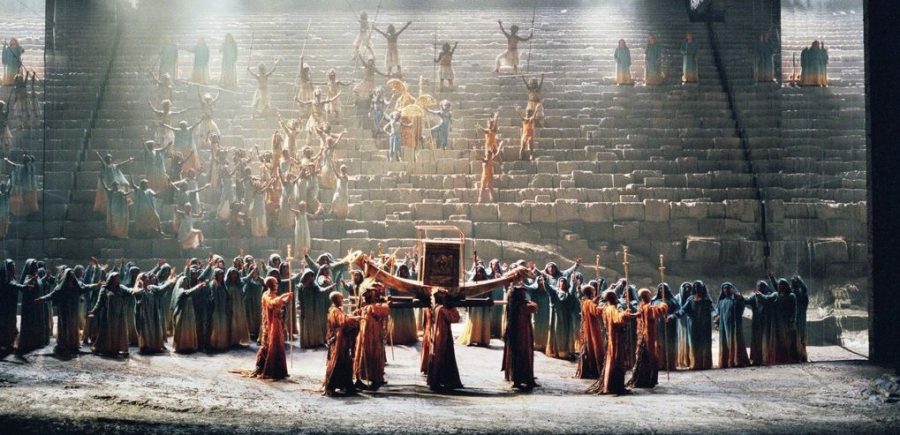
Verdi: Aida, Teatro Real, Madrid.
Madrid’s Teatro Real celebrated its 200th anniversary with an updated version of one of its most emblematic old productions, Aida with staging, scenery and costumes by Hugo de Ana. It was originally produced here in 1998 and has been borrowed by other houses around the world.
This year’s changes are considerable, with a vast array of translucent scrims and projections. Through ever-changing layers of gauze we are wafted back in time and place to colorful images of an exotic locale. While the look is lovely, the production reinforces outdated ethnic stereotypes.
This production ignores political correctness and includes racial tropes, as well as conflating geography from varied places. This is retrograde but it’s actually a return to what Giuseppe Verdi and Antonio Ghislanzoni intended in 1871. Their Egyptian setting was non-realistic, and based on the images of the Middle East that were prevalent in their time.
The librettist was a respected Italian journalist, poet and novelist who prescribed “a colonnade with statues and flowering shrubs from which may be seen the temples and palaces of Memphis and the pyramids.” His instruction for the triumphal scene is “Thebes, in front a clump of palms, a temple dedicated to Ammon,” even though pedants may wonder why the royal court would move many miles to have its victory parade. (Memphis and Thebes were capitals of Egypt at different times.) Thus, this production is historically inaccurate, but it creates a mood.
Introducing it is a shiny silver curtain, covered with hieroglyphics. When the curtain rises, beyond the projections are palm trees, statues, pillars, columns, obelisks, and a pyramid that slides forward to dominate the stage. Projections of pyramids and other triangular forms move repeatedly amongst the scenery. The triumphal march takes place in front of huge stone steps occupied by the chorus and trumpeters. The judgment scene is illuminated by a procession of torch-bearers. Cast members carry spears, shields, bows and arrows. Male dancers appear with bare buttocks and females with bare breasts. The principal female dancer, nearly nude, is at an advanced stage of pregnancy. It all seems barbaric, stereotypical — and, frankly, exciting.
The look is luxurious, but not as spectacular as a Zeffirelli extravaganza, nor the monumental mounting by Sonja Frisell and Gianni Quaranta which the Metropolitan Opera keeps repeating. This stage is much smaller than the Met’s and we have no elephants here.
I’ve been dwelling on the visual, because it’s more impressive than the aural. The cast is led by three sets of international stars who rotate during the production’s 17 dates and who give satisfactory but unthrilling performances. Liudmyla Monastyrska is powerful as Aida but a bit detached from emotion; she leaves us unmoved, and her pianissimi, so important in this role, are proper but not breath-taking.
Gregory Kunde presents a well-studied Radamès with good musicianship but little velvet. George Gagnidze’s Amonosro is ringing, stentorian, unsubtle. The most impressive of the principals at the performance I attended was Ekaterina Semenchuk as Amneris. Her mezzo voice is warm and rich, and she uses it effectively, especially in the judgment scene. De Ana’s production, however, gives her costumes and hair styling that are too similar to Aida’s. We’d like more visual contrast between slave and mistress.
The secondary characters are very well performed. Roberto Tagliavini shows a lovely, lyrical bass voice as Ramfis. Soloman Howard is a tall, young American bass who sings well as the king, while generously displaying his handsome torso. The young Mexican tenor Fabián Lara beautifully sings the tiny role of the messenger, and his future should be impressive.
Nicola Luisotti’s conducting is conventional. Leda Lojodice’s choreography is eye-catching for the reasons mentioned above. The most noticeable innovation in de Ana’s direction is his extensive employment of long ribbons and sashes. Sometimes they are tying people together, other times they just stretch across the stage. The intent, I surmise, is to indicate the inter-connection of the characters. I find it interesting that no one whom I conversed with at the opera had any idea what the ribbons suggested, nor did any other reviewer discuss the possible meaning.